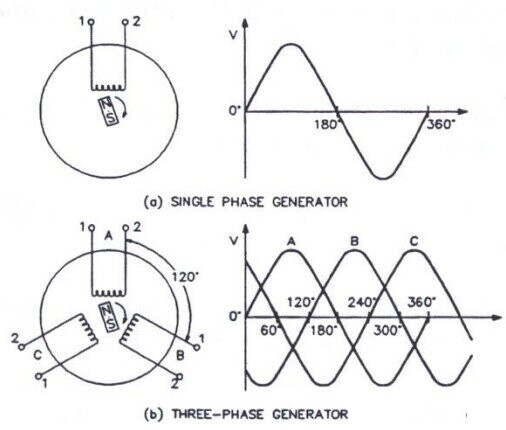Comparing Single-phase and Three-phase Diesel Generators
On this page
Diesel generators serve as crucial backup power equipment in various scenarios in modern life. However, for those unfamiliar with their technical terms and operational principles, the differences between single-phase and three-phase diesel generators can be confusing. This article delves into the characteristics, applications, and pros and cons of these two types of diesel generators.

Single-phase diesel generators are simple and commonly used power generation devices, consisting of three cables: live wire, neutral wire, and ground wire. These generators are typically small in size, with voltages ranging from 180 to 240 volts. Due to their relatively simple design and low cost, single-phase diesel generators are widely applied in many small-scale scenarios.
Pros and Cons
Pros: Simple structure, low cost, suitable for small-scale applications.
Cons: Since single-phase generators produce only one waveform, their power output may fluctuate during operation, making them unsuitable for high-power or constant voltage requirements.
Applications
Single-phase diesel generators are suitable for places with low power demand, such as small businesses, rural areas, or residential areas. In these places, large power equipment is usually not required, so single-phase generators can provide cost-effective power solutions.
Pros: Simple structure, low cost, suitable for small-scale applications.
Cons: Since single-phase generators produce only one waveform, their power output may fluctuate during operation, making them unsuitable for high-power or constant voltage requirements.
Applications
Single-phase diesel generators are suitable for places with low power demand, such as small businesses, rural areas, or residential areas. In these places, large power equipment is usually not required, so single-phase generators can provide cost-effective power solutions.
Compared to single-phase generators, three-phase diesel generators have different designs and operational principles. They consist of five cables, including three-phase live wires, one neutral wire, and one ground wire. Three-phase diesel generators are usually larger in size, with voltages ranging from 380 to 440 volts. Due to their stable power output and high reliability, three-phase diesel generators are commonly used in large commercial and industrial settings.
Pros and Cons
Pros: Stable power output, suitable for large-scale operations, high reliability.
Cons: Compared to single-phase generators, three-phase generators are more expensive and may appear cumbersome in small-scale applications.
Applications
Three-phase diesel generators are suitable for places requiring large power outputs, such as large offices, medical centers, factories, and construction sites. In these places, stable and high-power electricity supply is often needed, making three-phase generators the ideal choice.
Pros: Stable power output, suitable for large-scale operations, high reliability.
Cons: Compared to single-phase generators, three-phase generators are more expensive and may appear cumbersome in small-scale applications.
Applications
Three-phase diesel generators are suitable for places requiring large power outputs, such as large offices, medical centers, factories, and construction sites. In these places, stable and high-power electricity supply is often needed, making three-phase generators the ideal choice.
Technical Features Comparison
Single-phase generators generate electricity through a single conductor, while three-phase generators generate electricity through three conductors, resulting in more stable output characteristics.
The output voltage of single-phase generators is lower, suitable for small-load applications, while the output voltage of three-phase generators is higher, suitable for large-load applications.
Reliability Comparison
In the event of a network failure, the power supply of single-phase generators will be completely interrupted, while three-phase generators can maintain partial power supply, improving system reliability.
The choice between single-phase and three-phase diesel generators depends on specific application requirements and scenarios. For small-scale applications with limited budgets, single-phase generators may be more suitable. However, for large commercial and industrial settings, three-phase generators should be considered to meet stable and high-power electricity demands. We offer a variety of diesel generator models to meet the diverse needs of customers, providing reliable power solutions for both single-phase and three-phase requirements.

